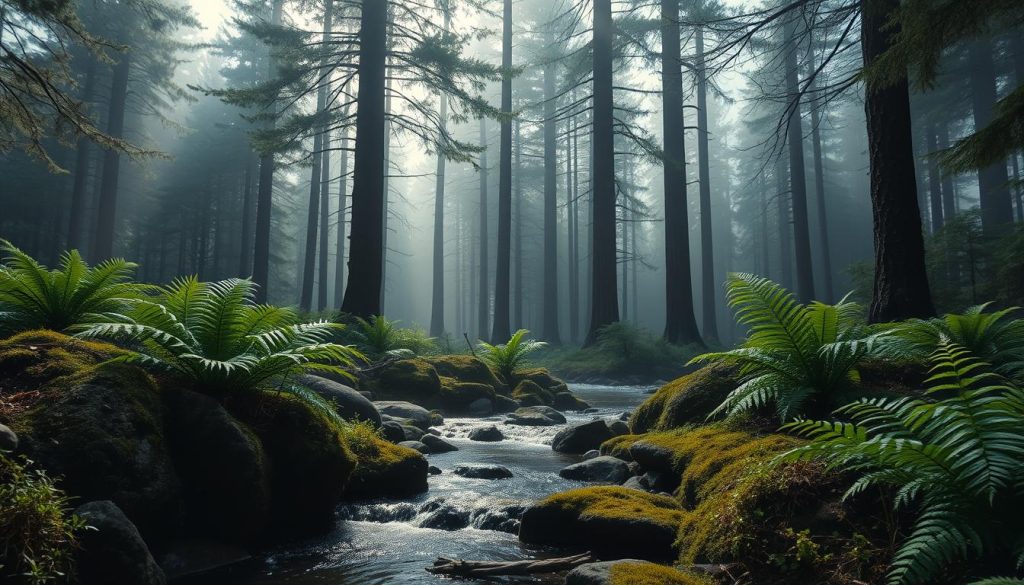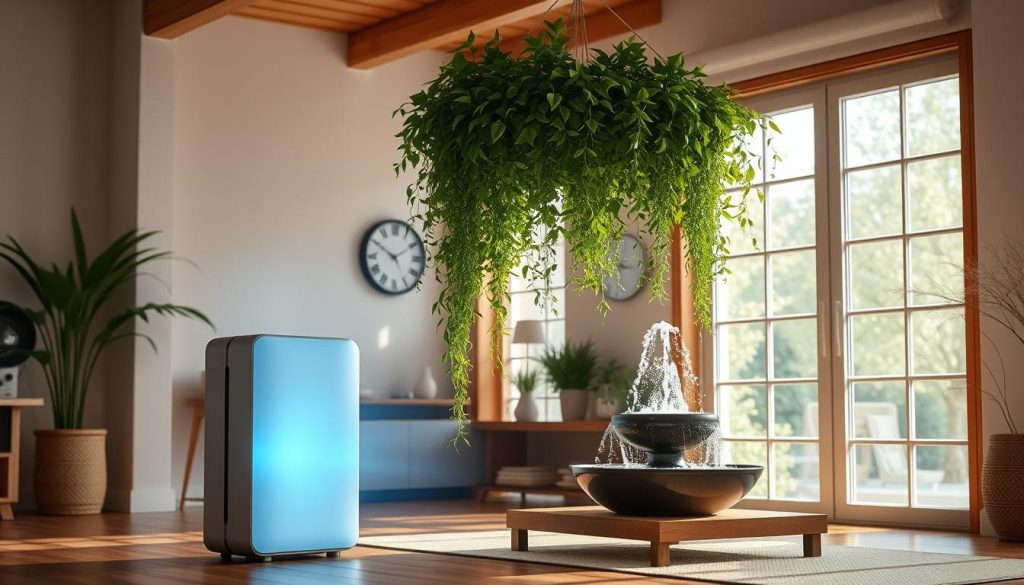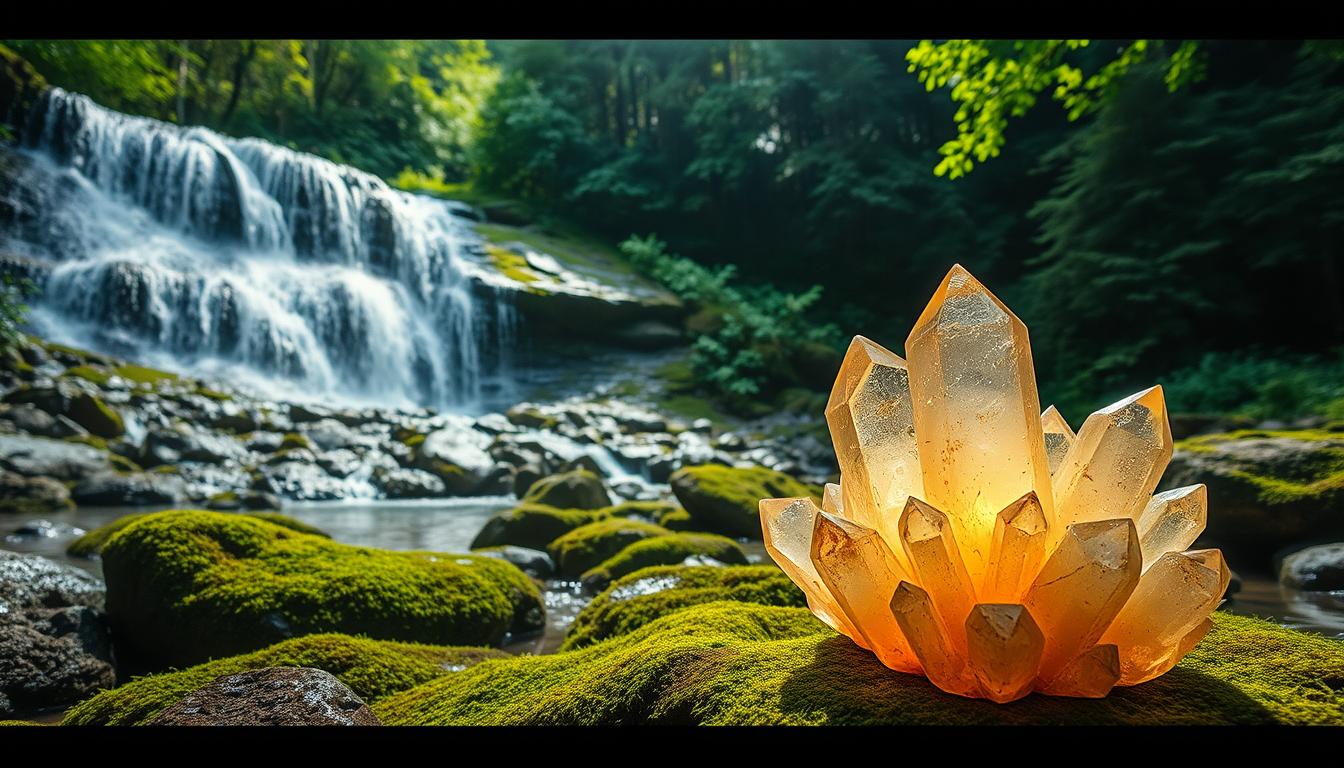Ever wondered about the invisible elements that make nature feel refreshing? Welcome to the world of natural negative ions. These tiny, charged particles are everywhere in nature. They can make you feel happier, more energetic, and overall better.
Let’s dive into the best places to find these negative ions in nature. We’ll explore everything from peaceful forests to stunning mountains and beautiful waterfalls. Learn how to enjoy these places and get the most health benefits from them.
Understanding Negative Ions and Their Health Benefits
Negative ions are molecules with extra electrons, giving them a negative charge. They are found in places with moving water, like waterfalls and ocean waves. They also exist in forests and mountains.
What Are Negative Ions?
Negative ions form when air molecules split apart due to sunlight, radiation, or moving air and water. This natural process creates many negatively charged ions in places like waterfalls, forests, and beaches. These ions help clean the air by pulling in and neutralizing pollutants and allergens.
Benefits of Negative Ions
The benefits of negative ions go beyond cleaner air. Studies show they can improve your overall well-being. They can make you feel more energetic, lift your mood, and reduce depression and anxiety symptoms. Plus, they may strengthen your immune system by boosting serotonin levels, which helps with sleep and stress.
Now, let’s explore the negative ion health benefits in more detail:
| Health Benefit | Description |
|---|---|
| Mood Improvement | Being around negative ions can help with depression and make you feel better overall. |
| Air Purification | Negative ions grab onto pollutants and allergens, making the air cleaner. |
| Energy Boost | Many people feel more energetic and less tired after being in places full of negative ions. |
| Better Sleep | Negative ions can help regulate your sleep by increasing serotonin levels, leading to better sleep quality. |
Where to Find Natural Negative Ions
Exploring the world of natural negative ions reveals that some places are better than others. These spots can greatly improve your health and happiness. By visiting these areas, you can fully experience the benefits of negative ions.
Mountains and Forests
Mountains and forests are top spots for natural negative ions. The high altitudes in mountains offer clean, fresh air full of negative ions. Forests, with their lush greenery, release these ions from trees and plants.
Walking in the woods can be a healing experience. It leaves you feeling refreshed and energized.

Waterfalls and Near Water Bodies
Waterfalls and water bodies are also great for negative ions. The falling water breaks down into negatively charged ions, filling the air. This makes areas near waterfalls, rivers, and oceans rich in negative ions.
Being near these water bodies can greatly improve your mood and energy.
The Science Behind Negative Ions
Negative ions have fascinated scientists for years. They’ve learned a lot about how these tiny particles affect our world and our health. These ions, mostly anions, have an extra electron. This extra electron gives them a negative charge, unlike their positive friends.
Negative ions form naturally in many ways, like when sunlight hits the Earth or during thunderstorms. Places like waterfalls and oceans have lots of them. This is because the movement of water and sunlight create these charged particles.
Research shows that negative ions can boost oxygen to the brain. This makes us feel more alert and awake. They can also help us feel less tired and more energetic.
Studies suggest that negative ions might help with depression by increasing serotonin levels. This is because they can affect our mood positively.
These ions also help clean the air we breathe. They get rid of harmful particles and allergens. This makes the air fresher, which is great for people with breathing problems.
The study of negative ions shows their many uses. For example, air purifiers and ionizers use this science to clean the air indoors. Learning more about negative ions could lead to even more ways to use them in our daily lives.
Negative Ions in Mountains and Forests
Mountains and forests are full of negative ions. These places are not just beautiful but also good for our health. They have lots of negative ions.
Why Forests Are Rich in Negative Ions
Forests have lots of negative ions because of their dense plants and natural processes. Trees and plants release negative ions into the air. Also, the movement of water in streams and rivers helps create more negative ions. This makes the air in forests better for our health.
Activities to Maximize Exposure in Forests
To get the most out of negative ions in nature, try outdoor activities in the forest. Here are some good ones:
- Hiking: Walk on trails through thick plants to get more negative ions.
- Meditation and Yoga: Do mindfulness exercises among trees to feel the negative ions’ healing power.
- Forest Bathing: This Japanese practice involves slow walks in the forest. It helps you connect with nature.

Doing these activities can make you healthier physically and mentally. It’s a great way to use nature’s power for good.
Negative Ions near Waterfalls and Water Bodies
Negative ions are found in many places, like near waterfalls and water bodies. Waterfalls are great at making negative ions because of the water’s constant flow. This flow releases negative ions into the air, which is good for our health.
How Waterfalls Generate Negative Ions
Waterfalls create negative ions when water falls and breaks apart molecules in the air. These negative ions then stick to positive ions, making the air cleaner. Waterfalls are perfect for this because the water keeps moving and making more negative ions.
Other Water Rich Environments
Places with lots of water, like oceans, lakes, and rivers, also make negative ions. The water’s movement, whether it’s waves or rivers flowing, always makes negative ions. This makes these places great for improving our well-being.
Let’s look at a comparison to understand better:
| Environment | Negative Ion Density | Example Activity |
|---|---|---|
| Waterfalls | High | Hiking near a waterfall |
| Oceans | Moderate | Walking along the beach |
| Lakes | Moderate | Boating |
| Rivers | Low to Moderate | Fishing |
The Role of Plants in Producing Negative Ions
Plants are more than just decorations. They help make our homes healthier by producing negative ions. This happens during photosynthesis, which is key for plant growth. It also improves the air we breathe and offers health benefits.
Best Plants for Increasing Negative Ions Indoors
Choosing the right plants can make a big difference. Some plants are better at cleaning the air and making negative ions. Here are the top picks:
- Areca Palm: This plant is great at purifying the air and making negative ions. It’s perfect for indoor spaces.
- Aloe Vera: Known for its health benefits, Aloe Vera also makes negative ions. This improves the air quality indoors.
- Spider Plant: Spider Plant is easy to care for and good at making negative ions. It also removes toxins from the air.
- Bamboo Palm: This plant is a great source of negative ions. It also adds beauty and greenery to any room.
- Peace Lily: Peace Lily is known for removing harmful pollutants. It’s a great choice for increasing negative ions at home.
Adding these plants to your home can make the air better. Negative ions can boost your mood, energy, and breathing.
Here’s a comparison of the best indoor plants for boosting negative ions:
| Plant | Notable Feature | Best Placement |
|---|---|---|
| Areca Palm | High negative ion production | Living Room |
| Aloe Vera | Medicinal properties | Bedroom |
| Spider Plant | Resilient and easy to maintain | Kitchen |
| Bamboo Palm | Elegant appearance | Living Room |
| Peace Lily | Neutralizes indoor pollutants | Bathroom |
Negative Ion-Rich Urban Locations
In our bustling cities, there are peaceful spots filled with negative ions. These places offer air as fresh as nature’s. Let’s look at some of these urban retreats.
Parks and Green Spaces
Parks and green areas in cities are key for negative ions. They have lots of trees and plants, just like forests. Visiting places like Central Park in New York or Golden Gate Park in San Francisco can be a breath of fresh air.
Urban Water Features
Water features like fountains and lakes in cities are full of negative ions. For example, Millennium Park in Chicago has a famous Crown Fountain. These spots make the air feel better and look great, improving our health and mood.
Natural Ways to Increase Negative Ions at Home
Boosting your home’s vibe by adding negative ions can make you feel better. You can do this by adding natural elements. Using indoor plants and water features are great ways to start.
Using Indoor Plants
Indoor plants are a fantastic way to add negative ions to your home. They make your space look good and clean the air. Spider plants, peace lilies, and Boston ferns are top choices.
These plants are easy to care for. They can grow well in different indoor settings. This makes them perfect for any home.
Incorporating Water Features
Adding water features is another smart way to increase negative ions at home. Small fountains, aquariums, and indoor waterfalls mimic nature. They create negative ions constantly.
A tabletop fountain can be a cool addition to any room. It looks good and cleans the air. Aquariums also add to the calm and increase air ions.

Benefits of Negative Ion Generators and Boosting Products
Looking into the benefits of artificial negative ions can help us understand how to improve our well-being. Using negative ion generators and products can mimic the natural effects found in forests, mountains, and waterfalls.
Devices that Emit Negative Ions
Negative ion generators create negative ions using electricity. They are small and easy to use at home, in the office, or while traveling. Brands like Sharper Image and AirTamer make devices that claim to clean the air by removing pollutants and allergens.
Natural Negative Ion-Boosting Products
There are also natural products that boost negative ions. Himalayan salt lamps and beeswax candles are popular. They release negative ions when heated, making the air fresher and helping with relaxation and sleep.
Are Commercial Products Effective?
The success of commercial products depends on the technology and where they are used. Some people say they improve air quality and well-being. But, scientific studies on these products are limited. It’s important to look at both personal experiences and scientific research before buying.
- Research and choose reputable brands for proven results.
- Combine multiple methods like generators and natural boosters for optimal impact.
- Regularly maintain devices to ensure continued effectiveness.
How to Maximize Your Exposure to Natural Negative Ions
Getting more natural negative ions can really boost your health. Find the best ways to soak up these ions outdoors and indoors. This will help you enjoy their health benefits.
Outdoor Activities
Being outside is a great way to get more negative ions. Here are some activities to try:
- Hiking and Forest Walks: Forests are full of negative ions. They’re perfect for long hikes and walks.
- Visiting Waterfalls: Waterfalls have lots of negative ions. They’re a great place to spend time.
- Beach Outings: The air by the sea is full of negative ions. It’s a great spot for fun outdoors.
Indoor Measures
There are also ways to get more negative ions inside. These steps can make your home healthier:
- Using Indoor Plants: Some plants, like peace lilies and spider plants, increase negative ions indoors.
- Incorporating Water Features: Indoor fountains and water features release negative ions. They improve your home’s air quality.
- Airing Out Spaces: Open windows often to let in fresh air. This raises the negative ion levels inside.
By using these outdoor and indoor tips, you can increase your negative ion exposure. This will help you live a healthier, more balanced life.
Real-Life Experiences: The Power of Negative Ions
Many people have shared how negative ions have changed their lives. They feel more energized and have fewer allergy symptoms. Spending time near waterfalls or in dense forests is like a natural stress relief, say nature lovers.
An avid hiker says, “Visiting Shenandoah National Park always makes me feel new again. Hiking in the dense foliage, where negative ions are plentiful, boosts my mood and clears my mind.” Such stories show how negative ions can improve our mental and physical health.
City folks also find peace in urban parks. An office worker notes, “Taking breaks in Central Park boosts my productivity and happiness. The fresh air with negative ions is like a natural cure for my indoor job.” These experiences prove that negative ions can make a real difference in our daily lives.

